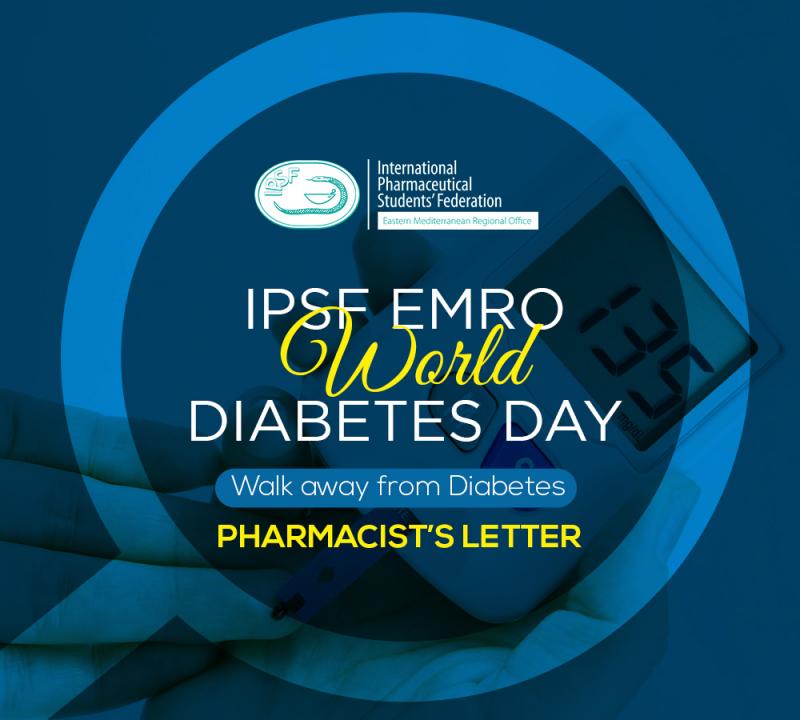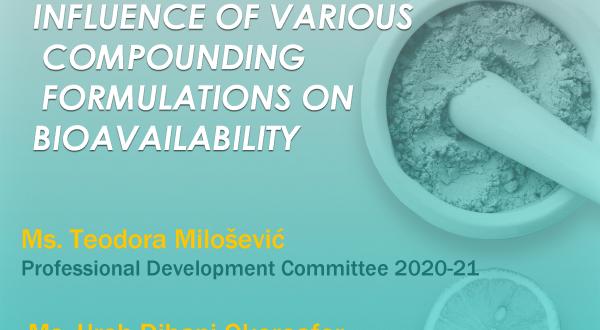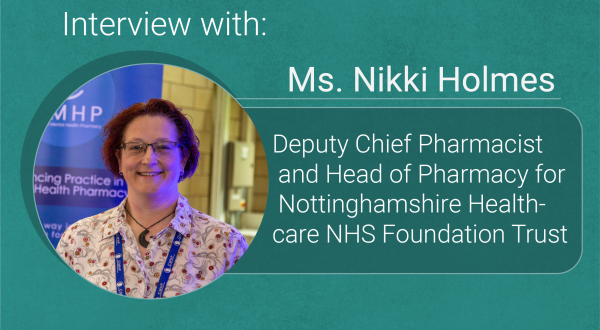
[IPSF EMRO] Pharmacist's Letter 1st Edition - World Diabetes Day
Diabetes occurs when the body is unable to regulate the amount of glucose (sugar) in the blood and we have 2 types of diabetes
What is Diabetes?
- Diabetes occurs when the body is unable to regulate the amount of glucose (sugar) in the blood. Normally, the body produces enough insulin to keep the blood glucose level between ideal levels (fasting glucose between 0.70g/l and 1.10g/l ) .But people with diabetes are not able to remove excess glucose from the blood and the BGL rises. There are two main types of diabetes
- Type 1 Diabetes:
- The pancreas cannot make insulin and need to have insulin injections right from the start
- Type 2 Diabetes:
- some insulin is still produced, but it does not work properly, known as insulin resistance
- some people may need tablets or insulin as diabetes progresses
The mechanism and side effects of diabetes medications:
|
Medication |
Mechanism of action |
Side effects |
|
Alpha-glucosidase inhibitors |
Acarbose (Precose) and miglitol (Glyset) are alpha-glucosidase inhibitors. These drugs help the body to lower blood sugar levels by blocking the breakdown of starches. |
They should be taken with the first bite of a meal. These drugs may have side effects, including gas and diarrhea.
|
|
Biguanides |
Metformin (Glucophage) is a biguanide. Biguanides lower blood sugar levels primarily by decreasing the amount of glucose produced by the liver. Metformin helps to lower blood sugar levels by making muscle tissue more sensitive to insulin so glucose can be absorbed. |
It is usually taken two times a day. A side effect of metformin may be diarrhea, but this is improved when the drug is taken with food. |
|
Bile Acid Sequestrants
|
The BAS colesevelam (Welchol) is a cholesterol-lowering medication that also reduces blood sugar levels in patients with diabetes. BASs help remove cholesterol from the body, particularly LDL cholesterol, which is often elevated in people with diabetes. |
They are usually safe for use by patients who may not be able to use other medications because of liver problems. Because of the way they work, the side effects of BASs can include flatulence and constipation. |
|
Dopamine-2 Agonists
|
Bromocriptine (Cycloset and Parlodel) helps lower blood sugar levels after a meal.
|
Not relevant |
|
DPP-4 inhibitors
|
A new class of medications called DPP-4 inhibitors help improve A1C without causing hypoglycemia. They work by preventing the breakdown of a naturally occurring compound in the body, GLP-1. GLP-1 reduces blood sugar levels in the body but is broken down very quickly so it does not work well when injected as a drug. |
None
|
|
Meglitinides
|
Meglitinides are drugs that also stimulate the beta cells to release insulin. |
Nateglinide (Starlix) and repaglinide(Prandin) are meglitinides. They are taken before each of three meals. Because sulfonylureas and meglitinides stimulate the release of insulin, it is possible to have hypoglycemia (low blood sugar levels).
|
|
SGLT2 Inhibitors
|
Glucose in the bloodstream passes through the kidneys, where it can either be excreted or reabsorbed. Sodium-glucose transporter 2 (SGLT2) works in the kidney to reabsorb glucose, and a new class of medication, SGLT2 inhibitors, block this action, causing excess glucose to be eliminated in the urine. |
Canagliflozin (Invokana), dapagliflozin (Farxiga), and empagliflozin (Jardiance) are SGLT2 inhibitors that have been approved by the FDA to treat type 2 diabetes. Because they increase glucose levels in the urine, side effects can include urinary tract and yeast infections.
|
|
Sulfonylureas
|
Sulfonylureas stimulate the beta cells of the pancreas to release more insulin. . Chlorpropamide (Diabinese) is the only first-generation sulfonylurea still in use today. The second-generation sulfonylureas are used in smaller doses than the first-generation drugs.
|
Generally hypoglycemia, weight gain and dark-colored urine. |
|
TZDs(Thiazolidinediones) |
Rosiglitazone (Avandia) and pioglitazone (ACTOS) are in a group of drugs called thiazolidinediones. These drugs help insulin work better in the muscle and fat and also reduce glucose production in the liver. |
Both drugs appear to increase the risk for heart failure in some individuals, and there is a debate about whether rosiglitazone may contribute to an increased risk for heart attacks. Both drugs are effective at reducing A1C and generally have few side effects.
|
|
|
|
|
Interaction between different diabetes medications:
Patients with diabetes have a higher pill burden than the general population, so pharmacists should pay particular attention to potential drug interactions with antidiabetic agents.
|
Sulfonylurea-induced hypoglycemia is worsened by |
co-administration with azole antifungals, clarithromycin, verapamil, angiotensin-converting enzyme. (ACE) inhibitors, DPP-4s, and GLP-1 agonists |
|
Metformin toxicity is more likely with |
anticholinergics because of increased absorption and nephrotoxic agents. (eg, iodinated contrast media) |
|
Thiazolidinedione toxicity is heightened by |
CYP P450 2C8 inhibitors. (eg, ketoconazole, gemfibrozil, rifampicin, fluvoxamine, and trimethoprim)
|
|
Saxagliptin concentration is affected by |
CYP3A4 inhibitors and inducers and ACE inhibitors increase the risk of bradykinin-induced angioedema. |
|
Ginseng induces CYP3A4 |
(decreasing glibenclamide, pioglitazone, meglitinides, sitagliptin, and saxagliptin concentrations) and stimulates insulin secretion.
|
|
St. John’s wort induces CYP3A4, 1A2, 2D6, and 2E1 |
(decreasing sulfonylureas, thiazolidinediones, meglitinides, and DPP-4 inhibitors) and induces p-glycoprotein pumps.
|
|
Sulfonylureas, thiazolidinediones, and meglitinides are affected by |
hepatic enzyme interactions, metformin toxicity is mediated by nephrotoxicity, and dipeptidyl-peptidase-4 inhibitors are less affected by hepatic enzymes. between antidiabetics and other meds.
|
Diabetes Patient Counselling:
The role of pharmacists is to provide patient counseling for their patients suffering from Diabetes 1 and 2 by focusing on blood sugar levels and nutrition.
|
TYPE 1 DIABETES |
TYPE 2 DIABETES |
|
*Healthy eating to lose weight if overweight *Being more physically active (at least 30 minutes of physical activity per day) *Avoiding smoking
|
|
(this part is for both type 1 and type 2) For Nutrition : Eating doesn’t have to be boring. It’s all about finding the right balance that works for you.
When you’re managing diabetes, eating healthy can feel boring and dull, right? Don’t give up! The one key to feeling your best lies in the food you eat:
|
|



